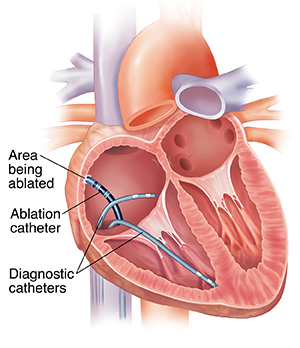Having Catheter Ablation
Having Catheter Ablation
A heart rhythm problem (arrhythmia) can make your heart beat too fast or in an irregular pattern. The problem is often caused by cells in your heart that aren’t working as they should. Or, it may be the result of an abnormal electric circuit. It may cause bothersome symptoms, such as an irregular heartbeat, dizziness, shortness of breath, chest pain, or fainting. Your doctor has recommended catheter ablation to treat your arrhythmia. This non-surgical procedure destroys the cells that are causing the problem.
Before the procedure

Before your catheter ablation, you will meet with a specially trained heart doctor (cardiac electrophysiologist) who will do the procedure. He or she will tell you how to get ready. You will likely be told to stop or change your heart rhythm medicines for a period of time before the procedure. Follow your doctor’s instructions. Also:
-
Tell the doctor about all prescription and over-the-counter medicines you take. This includes herbs, supplements, and vitamins. It also includes daily medicines, such as insulin or blood thinners. If you are allergic to any medicines, tell the doctor.
-
Have any routine tests, such as blood tests, as recommended.
-
Don’t eat or drink anything 12 hours before the procedure.
How catheter ablation is done
Catheter ablation uses thin, flexible wires (electrode catheters) to find and destroy (ablate) problem cells. Here’s how the procedure is done:
-
The heart’s signals are mapped. To find the problem, an electrophysiology study (EPS) is done. During this study, the doctor tries to start (induce) your arrhythmia. An electrical map of the heart is then created. This shows the type of arrhythmia you have and where the problem is. Using the map as a guide, the doctor knows where to ablate.
-
Problem areas are destroyed using heat or cold therapy. Once the EPS shows where the problem is, the doctor threads an electrode catheter through a blood vessel to that area in the heart. Energy is sent through the catheter to destroy the problem cells.
-
The heart’s rhythm is tested again. After ablating the problem cells, the doctor tries to restart (reinduce) your arrhythmia. If a fast rhythm can’t be induced, the ablation is a success. But if a fast rhythm does start again, you may need more ablation.
Your experience during catheter ablation
In most cases, catheter ablation is done in an electrophysiology (EP) lab. It often takes 2 to 4 hours, and sometimes longer. You’ll receive medicine to prevent pain. Medicine will also help you relax or sleep during the procedure. If you feel uncomfortable during the procedure, tell the doctor or nurse:
-
First, the healthcare team washes the skin on your groin (or rarely, the neck). Any hair in that area may be removed. This is where the catheters will be inserted. An IV (intravenous) line is started in your arm. Medicines and fluids are given through this IV. To help keep the insertion site germ-free (sterile), your body is draped with sheets. Only the area where the catheters will be inserted is exposed.
-
The healthcare provider numbs the skin where the catheters will be inserted with pain medicine (local anesthetic). Then the provider uses a small needle to make punctures in your vein or artery. He or she puts catheters through these punctures and guides them to your heart. The provider uses X-ray monitors to help guide the catheters.
-
The provider then puts wires in several places in the heart to map the electrical signals. The wires also stimulate the heart.
-
When the procedure is finished, the provider takes the catheters out of your body. He or she puts pressure on the puncture sites to stop any bleeding. No stitches are needed. You’re then taken to a recovery room to rest. You'll need to remain lying down for 2 to 6 hours. You'll also be asked not to move the leg where the catheters were inserted for a few hours. This is to make sure the insertion sites don't bleed. You may be able to go home on the same day as the procedure.
Risks and possible complications
The risks of catheter ablation are fairly low compared to the benefits you receive. Discuss these risks with your doctor before the procedure. Possible risks and complications include:
-
Bleeding or bruising at the catheter insertion site
-
Blood clots
-
A slow heart rhythm (requiring a permanent pacemaker)
-
Perforation of the heart muscle, blood vessel, or lung (may require an emergency procedure)
-
Damage to a heart valve (rare)
-
Stroke or heart attack, also known as acute myocardial infarction, or AMI (rare)
-
Infection, which is a risk after any invasive procedure. This may be indicated by a fever of 100.4°F (38.0°C) or higher, drainage, or redness and pain at the catheter insertion site.
-
Death (extremely rare)
Updated:
September 17, 2019
Sources:
Dellinger, Surviving Sepsis Campaign,, International Guidelines for Management of Severe Sepsis and Septic Shock, Critical Care Medicine (2013); 41(2);580-637
Reviewed By:
Steven Kang MD,Lu Cunningham RN BSN,Lu Cunningham RN BSN